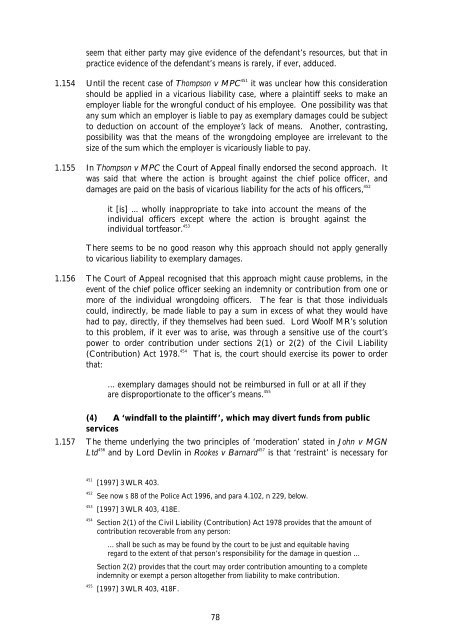Aggravated, Exemplary and Restitutionary ... - Law Commission
Aggravated, Exemplary and Restitutionary ... - Law Commission
Aggravated, Exemplary and Restitutionary ... - Law Commission
You also want an ePaper? Increase the reach of your titles
YUMPU automatically turns print PDFs into web optimized ePapers that Google loves.
seem that either party may give evidence of the defendant’s resources, but that in<br />
practice evidence of the defendant’s means is rarely, if ever, adduced.<br />
1.154 Until the recent case of Thompson v MPC 451<br />
it was unclear how this consideration<br />
should be applied in a vicarious liability case, where a plaintiff seeks to make an<br />
employer liable for the wrongful conduct of his employee. One possibility was that<br />
any sum which an employer is liable to pay as exemplary damages could be subject<br />
to deduction on account of the employee’s lack of means. Another, contrasting,<br />
possibility was that the means of the wrongdoing employee are irrelevant to the<br />
size of the sum which the employer is vicariously liable to pay.<br />
1.155 In Thompson v MPC the Court of Appeal finally endorsed the second approach. It<br />
was said that where the action is brought against the chief police officer, <strong>and</strong><br />
damages are paid on the basis of vicarious liability for the acts of his officers, 452<br />
it [is] ... wholly inappropriate to take into account the means of the<br />
individual officers except where the action is brought against the<br />
individual tortfeasor. 453<br />
There seems to be no good reason why this approach should not apply generally<br />
to vicarious liability to exemplary damages.<br />
1.156 The Court of Appeal recognised that this approach might cause problems, in the<br />
event of the chief police officer seeking an indemnity or contribution from one or<br />
more of the individual wrongdoing officers. The fear is that those individuals<br />
could, indirectly, be made liable to pay a sum in excess of what they would have<br />
had to pay, directly, if they themselves had been sued. Lord Woolf MR’s solution<br />
to this problem, if it ever was to arise, was through a sensitive use of the court’s<br />
power to order contribution under sections 2(1) or 2(2) of the Civil Liability<br />
(Contribution) Act 1978. 454<br />
That is, the court should exercise its power to order<br />
that:<br />
... exemplary damages should not be reimbursed in full or at all if they<br />
are disproportionate to the officer’s means. 455<br />
(4) A ‘windfall to the plaintiff’, which may divert funds from public<br />
services<br />
1.157 The theme underlying the two principles of ‘moderation’ stated in John v MGN<br />
Ltd 456<br />
<strong>and</strong> by Lord Devlin in Rookes v Barnard 457<br />
is that ‘restraint’ is necessary for<br />
451 [1997] 3 WLR 403.<br />
452 See now s 88 of the Police Act 1996, <strong>and</strong> para 4.102, n 229, below.<br />
453 [1997] 3 WLR 403, 418E.<br />
454 Section 2(1) of the Civil Liability (Contribution) Act 1978 provides that the amount of<br />
contribution recoverable from any person:<br />
... shall be such as may be found by the court to be just <strong>and</strong> equitable having<br />
regard to the extent of that person’s responsibility for the damage in question ...<br />
Section 2(2) provides that the court may order contribution amounting to a complete<br />
indemnity or exempt a person altogether from liability to make contribution.<br />
455 [1997] 3 WLR 403, 418F.<br />
78
















